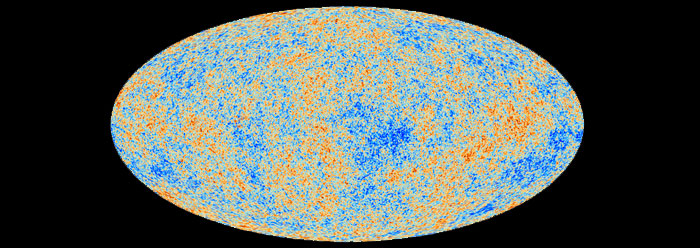 The
Planck Data and the Big Bang by Jake Hebert, Ph.D. *
The
Planck Data and the Big Bang by Jake Hebert, Ph.D. *
On March 21, 2013, the European Space Agency (ESA) published a new image of the cosmic microwave background (CMB) radiation, generated from data collected by the Planck space telescope. Big Bang cosmologists interpret the CMB to be "left-over" radiation from a time about 380,000 years after the alleged Big Bang.1 These are the highest resolution images of the CMB to date.
The Planck probe's ability to detect minute temperature fluctuations (around a millionth of a degree Celsius) in the CMB is certainly technologically impressive. In order to measure these tiny fluctuations, the satellite's detectors were cooled to the incredibly low temperature of just a tenth of a degree above absolute zero (about -273 ºC)!2
These higher precision measurements have led to revisions in some of the numbers important to Big Bang cosmologists. They have now revised their estimate of the universe's age slightly upward to 13.8 billion years old. They have also made small revisions in their estimates for the amount of "dark energy" and "dark matter" they believe to exist.
Media outlets are making somewhat contradictory claims about the Planck data. It's being said that the data support the Big Bang model of the universe's origin, but also that there are unexpected features in the data. Great Britain's The Telegraph, for instance, said that "[n]ew images capturing the ‘oldest light' in the universe have confirmed the Big Bang theory, but revealed new mysteries that are not explained by current scientific models."3
In fact, the European Space Agency has noted that some of the unexplained features in the CMB may "well require new physics to be understood."4 The website of CNES, the French space agency, even went so far as to acknowledge that the existence of these anomalies in the CMB "might challenge the very foundations of cosmology."5
New physics? Challenging the foundations of cosmology? How then can Big Bang supporters claim that these new data confirm the Big Bang?
Bible-believing Christians should welcome these higher-precision measurements. These data have confirmed the existence of an "asymmetry" in the CMB between opposite hemispheres of the sky that indicates a preferred or special direction in space. This so-called "axis of evil" had previously troubled Big Bang cosmologists, since the Big Bang model predicts that the universe should be isotropic, that is, the same in any direction in space. Hence there should not be any preferred directions in space! This is a fundamental assumption of Big Bang cosmology.6 As a consequence of this assumption, Big Bang cosmologists expect the CMB to be (with the exception of these very small temperature differences) isotropic, as well. And yet the Planck satellite has confirmed the existence of this anomaly which violates their assumption.
George Efstathiou, one of the lead researchers on the Planck mission, described this asymmetry as an "extremely strange result."7 Because of the lower resolution of earlier CMB measurements, Big Bang cosmologists could previously argue that this suspected anomaly might not be real. Now that it has been confirmed to exist, they no longer have that convenient option.
Newer, higher-resolution data can only spell "bad news" for those seeking to explain our existence apart from our Creator. In Darwin's day, complete ignorance of the cell's fantastic complexity helped to obscure some of the enormous difficulties in secular "origin of life" scenarios. Increased knowledge and understanding of the inner workings of the cell have exposed still more problems in evolutionary claims. This trend in biology will no doubt also prove true in astronomy and cosmology.
References
- Rundle, M. European Space Agency's Planck Satellite Reveals Most Precise Image Ever Made of The Primordial Universe. The Huffington Post. Posted on www.huffington.post 3/21/2013, accessed on 03/25/2013.
- T.C. Inflation and creation. The Economist. Posted on www.economist.com 3/21/2013, accessed on 3/25/2013.
- Collins, N. New images confirm Big Bang theory. The Telegraph. Posted on www.telegraph.co.uk on 3/21/2013, accessed on 3/25/2013.
- Paramaguru, K. Planck Satellite Image Maps the 'Oldest Light' in the Universe. Time Newsfeed. Posted on www.newsfeed.time.com on 3/22/2013, accessed at 3/25/2013.
- Anonymous. CNES News. Presentation of the first cosmological results of Planck mission as well as its first all-sky images of the Cosmic Microwave Background. Posted on www.smsc.fr on 3/21/2013, accessed on 3/25/2013.
- Bergström, L. and Goobar, A. 2006. Cosmology and Particle Astrophysics 2nd ed. Chichester, UK: Springer Praxis Publishing, 61.
- Peplow, M. Planck telescope peers into primordial Universe. Nature. Posted on www.nature.com 3/21/2013, accessed on 3/25/2013.
Image credit: Copyright © 2013 European Space Agency. Adapted for use in accordance with federal copyright (fair use doctrine) law. Usage by ICR does not imply endorsement of copyright holders.
* Dr. Hebert is Research Associate at the Institute for Creation Research and received his Ph.D. in Physics from the University of Texas at Dallas.